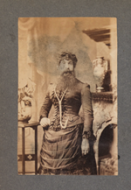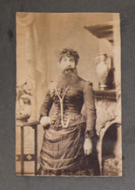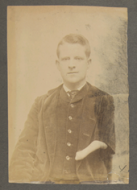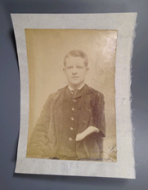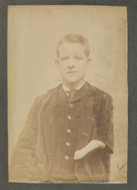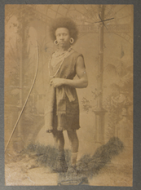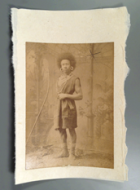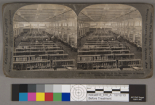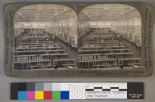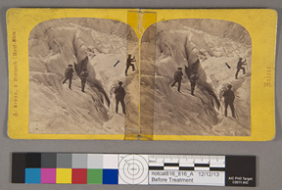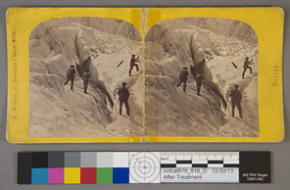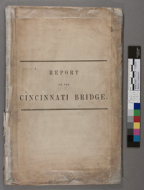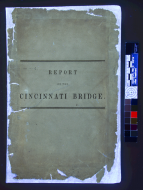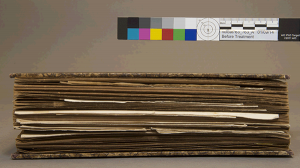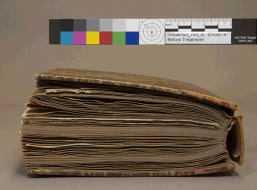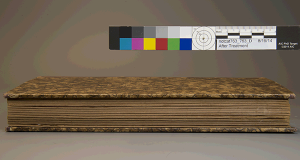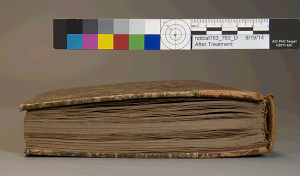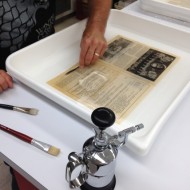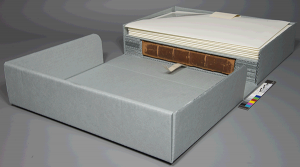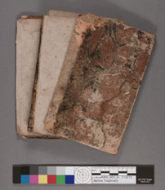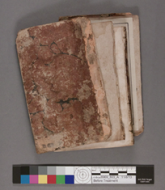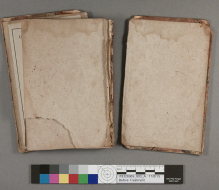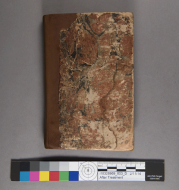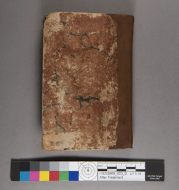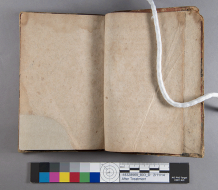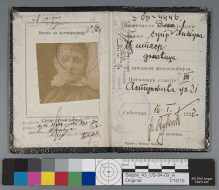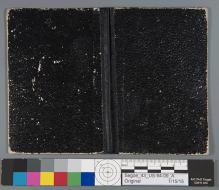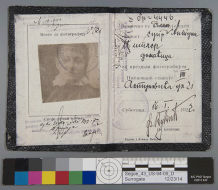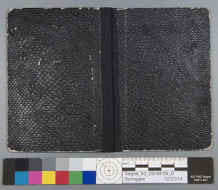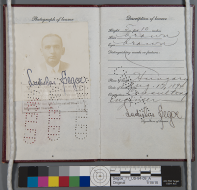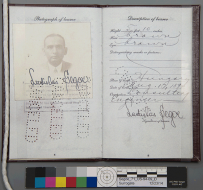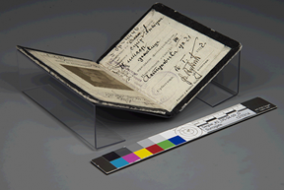In January of 2012, the Public Library of Cincinnati and Hamilton County (PLCH) and the University of Cincinnati Libraries (UCL) began a long-term collaboration to provide conservation and preservation treatments in an equally-managed, staffed and equipped preservation lab located in UC’s Walter C. Langsam Library.
Employees from both PLCH and UCL work on the general circulating and rare/special collections of each institution. The division of labor for all work performed by the Preservation Lab is divided evenly between UCL and PLCH and is tracked using a weighted point system.
A new exhibit, “Preserving the Past for the Future,” showcases the work done by the Preservation Lab on some rare/special items from both PLCH and UCL. Items in the exhibit range from photo albums to bridge reports to scrapbooks. The exhibit demonstrates both before and after images of the treatment done to the objects and explains the process. The exhibit was curated by Jessica Ebert, conservation technician, and designed by Amanda Jackson, communications co-op design student. The online exhibit was created by Lisa Haitz, web developer.
Below is the exhibit in its entirety. The physical exhibit is currently on display on Langsam Library’s 5th floor lobby.
(to see additional items, scroll on the right)
[nextpage title=”Album of Photographs of John Robinson’s Ten Big Shows (PLCH)” ]
Album of Photographs of John Robinson’s Ten Big Shows (PLCH)
Condition before treatment:
This early 20th century album documents John Robinson’s Circus, a company that toured the country for decades and had its winter headquarters in the Cincinnati suburb of Terrace Park. Though the album had already been digitized, many of the photographs had extremely distracting areas of discoloration. The dark regions found in some images were caused by a mysterious loss in the white photo paper causing the dark gray album pages to show through.
Treatment:
Our conservator lifted the mounted photographs from the album pages by softening the photo’s adhesive with solvents and carefully lifting with a microspatula. The photos were then backed with two layers of mulberry tissue adhered with methyl cellulose. Then they were placed back into the album with wheat starch paste.
The digitized Robinson album, which was digitized prior to treatment in the Lab, can be viewed online through the Public Library’s Virtual Library.
—-
(to see additional items, scroll on the right)
[/nextpage]
[nextpage title=”Stereographs (PLCH)” ]
– part of an exhibit called Double Vision: Seeing the World in Stereoscopic View
Condition before treatment:
Over 600 stereoview photos stored in 15 deteriorated cloth-covered boxes came from the Public Library in need of surface cleaning and rehousing. Six of the stereoviews exhibited at least one of the following condition issues: tears, delamination from the mount, and tape.
No. F51 – (7381), “Veronica Virginica”
Treatment:
The tear was mended with Japanese tissues and wheat paste. The areas of loss were filled with handmade paper toned with watercolors and buffed with a conservation wax emulsion to mimic the sheen of the photograph. The photograph was then adhered to the mount with wheat paste.
No. 22060 – “Rubber Boots (Akron, Ohio)”
Treatment:
This stereo view (as well as many others) was cleaned with a smoke sponge (a soft sponge made of vulcanized natural rubber) to gently reduce surface dirt. Next it was cleaned with vinyl eraser crumbs to evenly remove more dirt. Especially dirty silver gelatin photos (like this one) were further cleaned with cotton swabs lightly dampened with solvents.
(Left) Surface cleaning with smoke sponges, (Middle) surface cleaning with vinyl eraser crumbs, and (Right) aqueous surface cleaning with a cotton swab dampened with filtered water.
No. 3340 – “Oberland Bernois”
Treatment:
The tape was brushed with solvents to soften the adhesive. The carrier (the top layer of the tape) was lifted off with a thin microspatula. Yellowed adhesive left behind was carefully removed with cotton swabs and solvents. Areas damaged by the tape were inpainted with reversible watercolors. A shim of thin board was inserted between the layers of the mount board at the tear and the two sides adhered together with PVA (a common conservation adhesive that is strong and quick drying). The photograph mount was then mended with a thin but strong archival tissue and non-yellowing wheat starch paste.
(Left) A thin microspatula being used to separate layers of the board mount so that a shim can be inserted, (Middle) a protective layer of spun polyester was laid over one half of the photograph to protect it from adhesive, and (Right) shows the shim inserted into one side of the stereoview , with the removed tape in the background.
After treatment custom corrugated boxes were made for the stereo view photos and for their original, tattered boxes.
Find more information about the treatment of these stereo view photos on the Preservation Lab’s blog posts: The Stereoscope and Double Vision; and explore the Double Vision: Seeing the World in Stereoscopic View exhibit online through the exhibit through the Public Library’s Virtual Library.
—————
[/nextpage]
[nextpage title=”Report and Plan John Roebling” ]
Report and Plan for a Wire Suspension Bridge, Proposed to be Erected over the Ohio River by John Roebling (PLCH)
Condition before treatment:
This is John Roebling’s first report and plan for a wire suspension bridge over the Ohio River in Cincinnati. The pamphlet was in terrible condition and had previously been “repaired” with two types of pressure sensitive tapes, which covered many areas along the edges of the covers that had losses and tears throughout. The tapes had aged poorly and become brittle. The sewing of the textblock was also loose and the pages were dirty overall.
(Left) Photos show the object before treatment under normal illumination. (Right) These photos depict the object under ultraviolet radiation, which is used in conservation to help highlight previous repairs, staining and tide lines that are not as visible to the naked eye under normal light.
Treatment:
The pamphlet was disbound. The covers and text block were surfaced cleaned to remove loose dirt. The tape carriers were then removed using localized heat from a Zephrytronics hot air pencil. The covers and pages were very carefully cleaned further with vinyl eraser crumbs and block erasers. A solution of solvents was applied to isolated areas to reduce residual adhesive. The covers, text block, and foldouts were washed in water buffered to reduce acidity. Once dry the pages were sized with methyl cellulose to resist dirt from handling (except for the covers). The covers were lined overall to provide additional strength. Losses on the covers were filled with toned Japanese tissue and wheat paste. The pamphlet was then resewn as it was historically and the cover was reattached.
The “after” UV photos (right) illustrate how the washing reduced the tape adhesive staining caused by the previous repairs. Also, the tissue mends performed by the lab clearly fluoresce under the UV radiation, though they are not as readily apparent under normal illumination.
[/nextpage]
[nextpage title=”CCM Program Scrapbook” ]
CCM-Program Scrapbook (Archives & Rare Books Library – UCL)
Condition before treatment:
A scrapbook compiled by Mr. and Mrs. John A Hoffman containing CCM programs, newspaper clippings, letters and one silver gelatin photograph. John Hoffman was a director, teacher and conductor at CCM during the 1930’s and 1940’s. The scrapbook came to the Lab in preparation for digitization of the programs. Inserted material was either taped to the brown album paper with pressure sensitive tape or adhered along an edge with brown gum adhesive. The scrapbook had been so overstuffed with programs and clippings that the leather spine was broken at the joints and the binding had become wedge-shaped.
When all the programs and clippings were removed the binding relaxed noticeably and returned partly to its original form.
Treatment:
Attached programs, clippings and other ephemera were carefully removed from the scrapbook by using either a Zephrytronics hot air pencil (pressure sensitive tape) or gentle, localized humidification through a Gore Tex damp pack (brown gum adhesive). Once removed, programs that tested safe for washing were washed to remove staining from the brown gum adhesive.
(Left) Programs in the process of being washed, (Right) items go through several baths until the water is clear, then they remain in the water in order to carefully remove residual adhesive.
Once all ephemera was removed, fragile items were placed in polyester L-sleeves and then all items were placed in paper folders in the order they were removed from the binding. A custom corrugated enclosure was created to house the empty scrapbook and the paper folders containing the ephemera.
[/nextpage]
[nextpage title=”The Maniac” ]
The Maniac, with Other Poems by John Lawson (Archives & Rare Books Library – UCL)
Condition before treatment:
A book of poems from 1811, this quarter binding was missing its original leather spine. As a result, the front and back boards were detached. The red, blue and grey marbled paper on the covers remained though it had some significant abrasion. The sewing, which was on four recessed cord supports, was still intact. The pages were dirty and stained and the endsheets were detached with areas of loss and tears.
Before treatment (front, rear, rear interior)
Treatment:
The text block was surface cleaned with smoke sponges, then mended and filled with acrylic toned Sekishu tissue and Uso Mino Thin tissue. The spine was lined and flanges created with the lining tissue so the boards could be re-attached. A dark brown calf leather was pared overall and then the edges were pared even thinner with paring knifes. The leather was then attached with wheat paste to the boards underneath the lifted marbled paper. This process of replacing the original or missing spine of a book is known as a reback. Many special collections rebacks in the lab are done with toned kozo tissue and/or toned linen because they are durable and stable materials. Occasionally the curator of a collection will ask for a leather reback, though it is not common as leather is a more expensive material and can be time-consuming to work with.
After treatment (front, rear, rear interior)
[/nextpage]
[nextpage title=”Vilma Segoe’s Identification Card” ]
Vilma Segoe’s Identification Card (1921) & Ladislas Segoe’s United States Passport (1928) (UCL) – Originals and the surrogates created by Lab’s intern for a traveling exhibit entitled: IN THE PUBLIC INTEREST: The Life and Work of Regional Planning Pioneer Ladislas Segoe (1894-1983). *(Originals are part of the Archives & Rare Books Library collection; exhibit curated by DAAP faculty)
Handmade surrogates for exhibition:
Exhibit preparation is another aspect of conservation the Lab occasionally handles as exhibits are being curated at the Public Library and UCL. IN THE PUBLIC INTEREST is a UC exhibit which focuses on the life, work and some personal artifacts belonging to Ladislas Segoe. The Lab’s conservator, librarian and various staff members were involved in the initial planning of the exhibit to determine which items could safely travel and be exhibited, which items would need surrogates created for exhibit in lieu of originals, which items would need treatment before exhibition, and how the items should be displayed and packed for exhibition and travel. Almost all the original items that could not travel and be exhibited received printed surrogates through digitization. Two passports from the 1920s: Vilma Segoe’s ID card and Ladislas Segoe’s US passport, were two exciting exceptions to this. A scanned image of the passport mounted on foam board could not convey the tactile experience of these very interesting pieces. Instead the Lab’s intern worked hard to replicate the passports and create two exhibit surrogates virtually identical to the originals.
Original of Vilma Segoe’s Identification Card, part of ARB Library’s collection (interior and exterior)
Surrogate of Vilma’s ID card (interior and exterior) created by the Lab’s pre-program intern; notice the textured paper cover of the surrogate, this was created using acrylic paint, kozo tissue and a two-part epoxy putty mold.
Ladislas Segoe’s United States Passport, the original (Left) and the surrogate (Right)
For both the passport and the ID card the original interior images were scanned on a scanner and then a high resolution copy was printed onto a variety of acid free papers from the Lab’s supplies. The paper that produced the most comparable image to the original was selected and used for the surrogate. Vivak custom cradles were created for each surrogate so they could be displayed properly in the exhibit.
In The Public Interest: The Life and Work of Regional Planning Pioneer Ladislas Segoe will be on display at the Philip M. Meyers, Jr. Memorial Gallery until April 5th. Then it will travel and be displayed at Cornell University in the fall of 2015 and Technion-Israel Institute of Technology in Haifa, Israel in the spring of 2016. You can find more information about the exhibit through the UC News press release, on the UCL blog, and on the Preservation Lab’s blog.
[/nextpage]
*All treatments were performed by or under the supervision of a trained book and paper conservator.
**Photos taken by Jessica Ebert, Ashleigh Schieszer, Catarina Figueirinhas, and Chris Voynovich.


